
Homebuild redundant submarine in-and exit Kiss style rebreather
After the oxydrant built for the Euronaut submarine, Stefan Tietze built the Exive rebreather. This article explores the considerations, design choices and testing. The article was previously published in #34_Wetnotes.
Exive the double rebreather
Many years of development have gone into the self-built mCCR EXIVE. A private project has resulted in a redundant double rebreather that breaks new ground in terms of lime tanks, distributor heads and counterlungs.
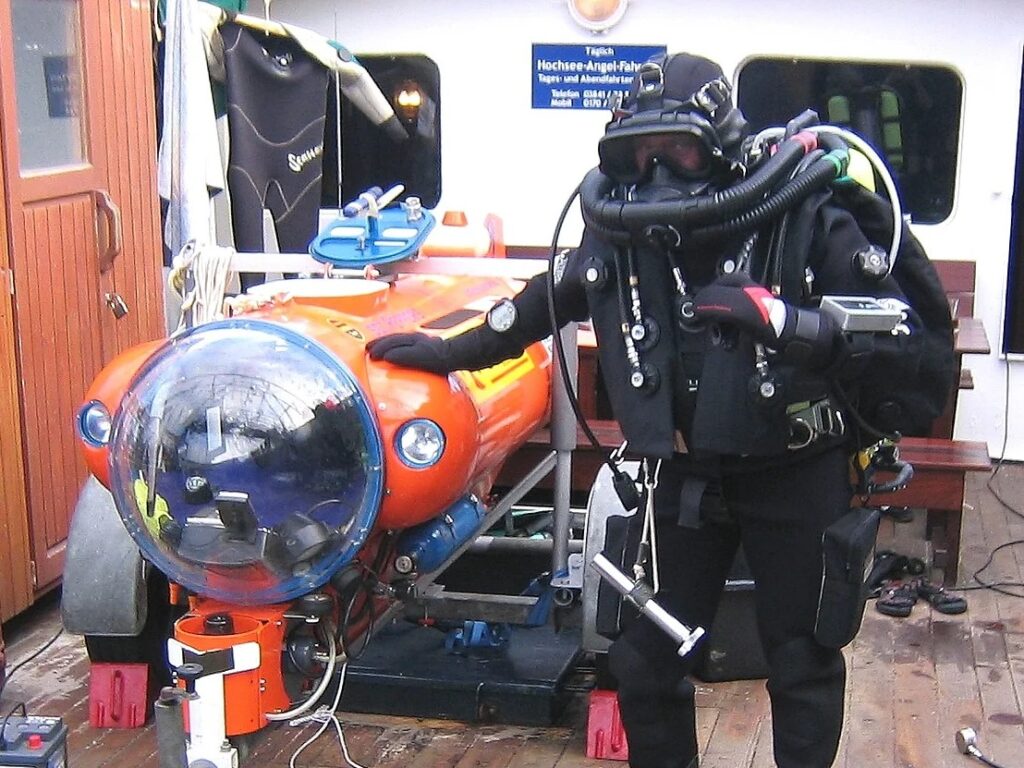
Stefan Tietze – the developer of EXIVE with his device on board the diving and expedition ship MS “Fritz Reuter”. Next to it is the 1-man submarine “Sgt. Pepper’s” by Carsten Standfuß (2006).
Between 2009 and 2020, I was involved in the construction and operation of the German research submarine “Euronaut”. I essentially owe both my professional career and diving as a life-filling hobby to this project. The unique feature of this submarine was a built-in 2-man diving chamber for wreck diving operations. Parallel to the development of the vehicle itself, former “Euronaut” crew member Stefan Tietze designed and built a special type of diving equipment. This is EXIVE – a rebreather that has complete functional redundancy apart from the gas cylinders. Although this device was not explicitly intended for use on a submarine, but for general use, its potential for use in the “Euronaut” project was recognized very early on. This application is the primary focus of this article.
Concept
With an operating depth of 250 meters and a diving chamber, “Euronaut” had capabilities that were previously only available to the authorities, large offshore companies or the military. However, the full potential of the project could only be realized if divers had access to the appropriate equipment. Anyone who wants to venture into wreck exploration with hours-long dwell times at depths beyond 100 metres will inevitably end up in the area of saturation diving. For safety reasons, this discipline in professional diving is traditionally dominated by hose-supplied systems or helmet diving equipment. The reason for this is that professional divers are solely responsible for and focused on carrying out their mission. The issues of gas logistics, dive planning and execution, medical monitoring and desaturation are monitored and controlled by the personnel on the supply vessel.
However, on a 16 meter long submarine with a diving chamber volume of approx. 7.4 m³, there is neither space nor energy available to set up the logistics that are available on board a much larger commercial or military DSV (Diver Support Vessel). The only practicable alternative for a hobby project in terms of the greatest possible diving depth, efficiency, optimum utilization of the gases carried and adequate safety is the use of a closed rebreather. By definition, rebreathers are complex technical devices whose use in a hostile environment is associated with risks of failure. It is therefore essential to have a bail-out concept that allows the diver to end the dive safely.

Simulation of the diver’s exit from the submarine’s exit hatch, which is only 77 centimeters (30″) wide
Diving from the submarine
This is where there is the first difference between technical diving and diving from a submarine. The reserve breathing gas supply in the event of a rebreather failure does not have to reach the surface. Similar to professional divers, who may have a decompression obligation of several days during a saturation dive and would have no chance of reaching the surface alive without a diving bell, a reserve supply for “Euronaut” divers only has to last for a limited time and distance back to the diving chamber. This formulates the first self-imposed requirement for the reserve equipment: It must last for at least 20 minutes. It is even better if it can act as a limited back-up in the diving chamber in the event of a temporary failure of the gas supply. Furthermore, the system must be compact enough to pass through a diver’s exit with a small diameter of 77 centimeters.
How do you ensure this reserve gas supply? There is simply not enough space in the diving chamber for bail-out stages. Side mount rebreathers had not yet been invented in the early 2000, i.e. at the time when “Euronaut” was designed and built, or at least were not sufficiently well known. In addition, they may limit the flexibility of boarding and disembarking through the narrow floor hatch. And even though carrying stages has become established in technical diving, it is still not everyone’s cup of tea to carry comparatively heavy and cumbersome additional cylinders. The only logical consequence under these conditions was a second functionally independent rebreather in the same housing. EXIVE (EXtended dIVE) pursues precisely this basic idea.
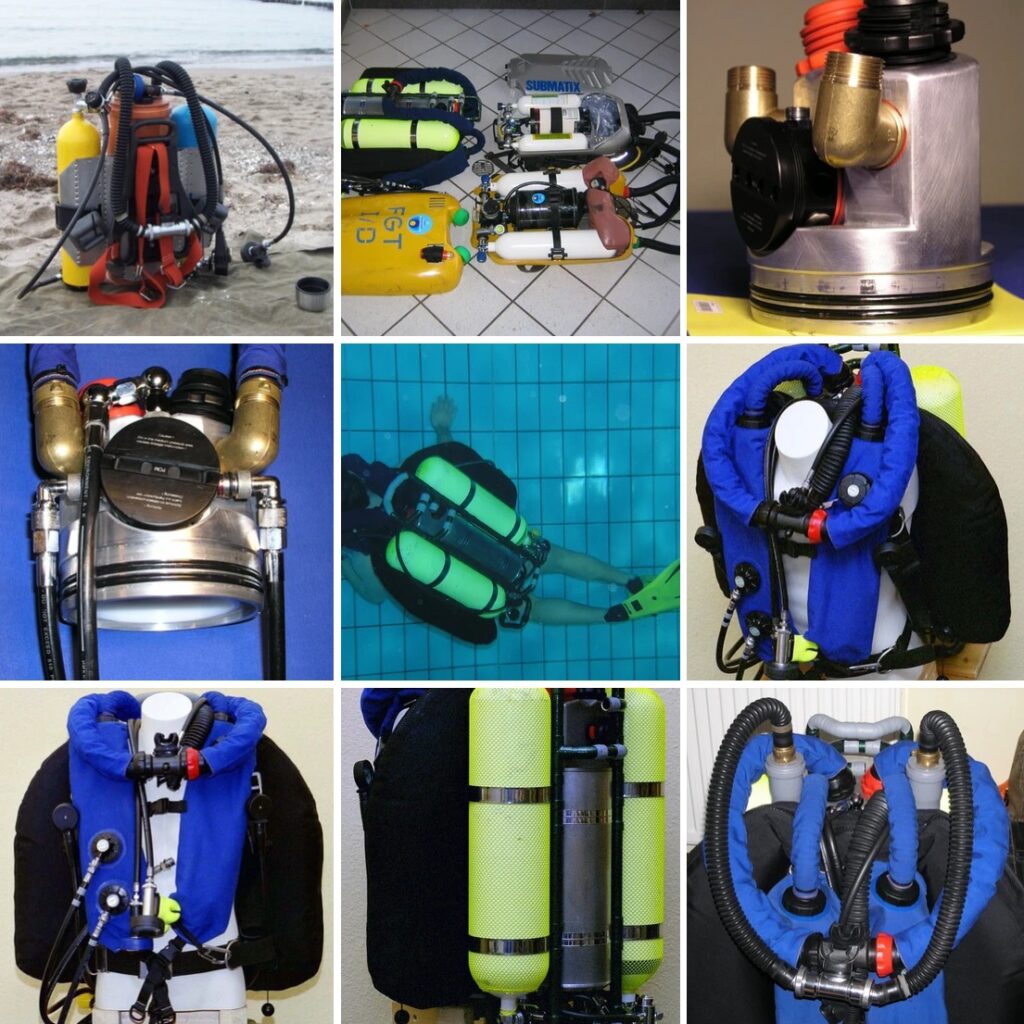
Development stages of the predecessor “Oxydrant” from the KG-pipe to the peak of its development in 2004.
Development
The device was developed iteratively over three different construction stages: Feasibility study, construction stage 1 (single-loop rebreather) and construction stage 2 (dual-loop rebreather). The project was supported by experienced divers, engineers, doctors and the rest of the “Euronaut” crew. Furthermore, the close co-operation with the company Submatix led to an intensive exchange of thoughts and ideas as well as the adoption of components from Submatix rebreathers.
In the initial development phases, many elements of the Dräger “Dolphin” SCR and DIY components were used in the device (then still called “Oxydrant”). This was later followed by stainless steel components developed in-house.
In 2006, the rebreather was presented in construction stage 2 at the university research and start-up ideas competition “Venture Sail” organised by the Patentverwertungsagentur-Mecklenburg-Vorpommern in Rostock and took the prize-winning 5th place. The prize money was used to further develop the device.
EXIVE completed a total of around 60 diving hours. If all previous prototypes are included, the total time spent underwater amounts to around 200 diving hours. The test areas were in the Baltic Sea, North Sea and inland waters (Wildschütz, Nordhausen, Hemmoor, Schweriner See, Helenesee and various quarry ponds). The highlights of the development were the participation in a wreck search expedition under the leadership of Klaus Keppler (“Sea Explorer AG”) and the testing at the “DSAT Tec Trimix Instuctor Trainer” in Kroatia
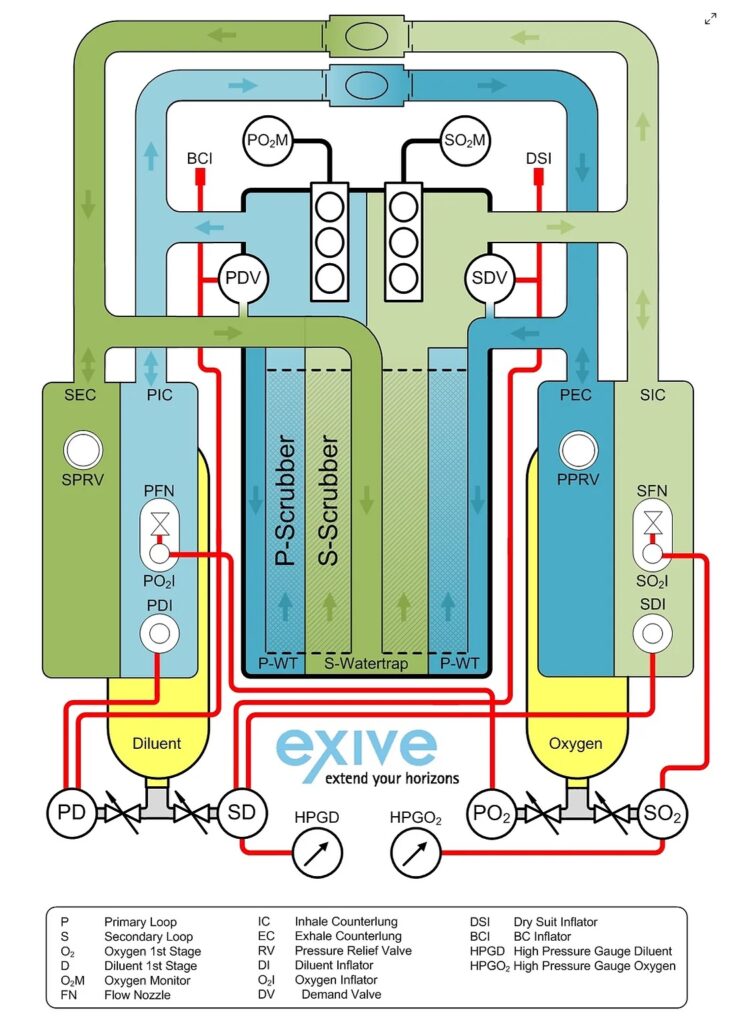
| p | Primary Loop | IC | Inhale Counterlung | OSI | Dry Suit Inflater |
| s | Secondary Loop | EC | Exhale Counterlung | BCI | BC lnflalor |
| 02 | Oxygen 1st Stage | RV | Pressure Relief Valve | HPGD | High Pressure Gauge Diluent |
| D | Diluent 1st Stage | DI | Dilluent lnflator | HPG02 | High Pressure Gauge Oxygen |
| 02M | Oxygen Monitor | 021 | Oxygen Inflater | ||
| FN | Flow Nozzle | DV | Demand Valve |
The principle
In functional terms, EXIVE is a conventional KISS-style mCCR in which all components from the cylinder valve to the loop are duplicated. All critical components have been newly developed in a space-saving design. In functional terms, EXIVE is a conventional KISS-style mCCR in which all components from the cylinder valve to the loop are duplicated. All critical components have been newly developed in a space-saving design.
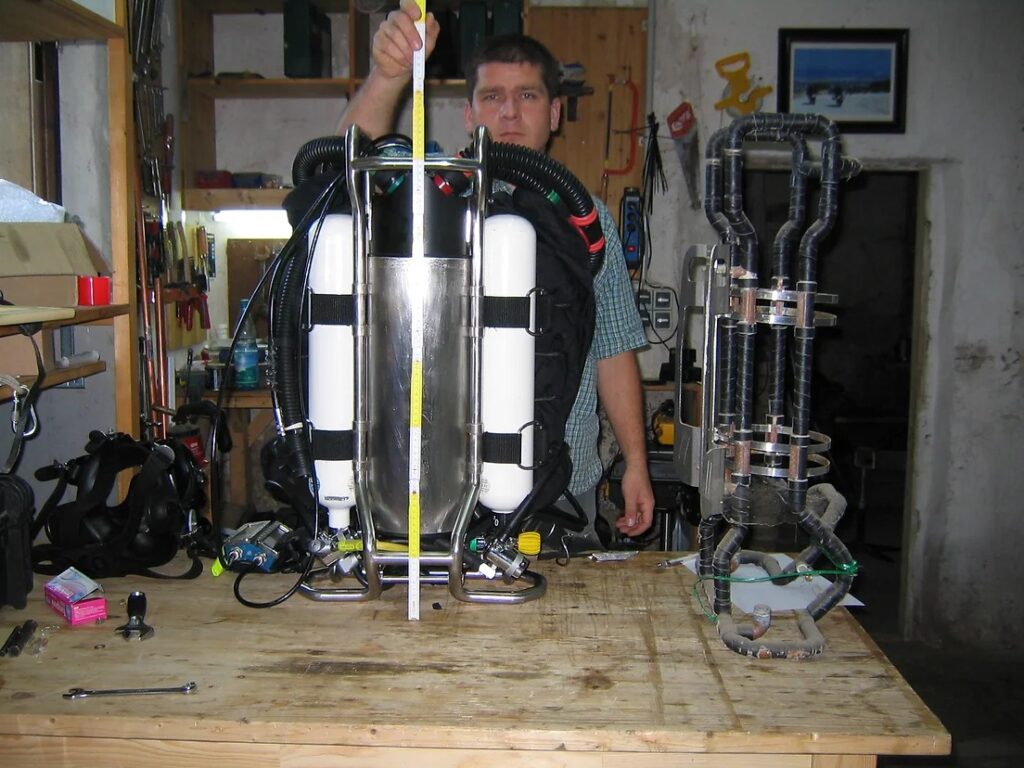
The stainless steel tubular frame of the EXIVE with attached main components. To the right is the copper tube test frame of the predecessor “Oxydrant”. The dimensions of the double rebreather differ only slightly from modern eCCR devices.
The tubular frame
A cover was deliberately omitted from the supporting structure. Otherwise, such a cover would make the appliance unnecessarily larger and heavier. In particular, the possibility of using different bottle sizes was not compatible with a concealed construction. The following requirements led to the design of the tubular frame:
– Supporting all appliance components;
– Protection of sensitive components from collision with flat surfaces in all directions;
– Easy assembly and disassembly of the appliance;
– Safe storage of the appliance in an upright and horizontal position;
– basic robustness in terms of handling equipment on board.
The tubular frame supports a stainless steel hull tube, which serves as a housing for the lime containers and as a holder for the distributor head.
The pressurised gas cylinders
Gas is supplied via pressurized gas cylinders next to the fuselage tube. Cylinders in sizes 3, 4, 5 and 7 litres can be used. The cylinders each have a cross-shaped double valve. This is also where the separation of the two rebreathers begins, which only ends again at the diver’s mouth. It can be assumed that the pressurized gas cylinders are fail-safe over the course of a dive. Each circuit is supplied with diluent and oxygen via a separate 1st stage. The hand wheels of the primary circuit point to the side, those of the secondary circuit point towards the diver’s buttocks. Designed in this way, all hand wheels are easy to reach and difficult to confuse.

Using two separate lime containers would have made the device too large and too heavy.
Instead, the two cylindrical limescale containers are arranged co-axially. The secondary container is inserted into the primary container. Proof of functionality was provided by means of a practical test to determine the CO2 reaction front inside the lime container.
The scrubber
In addition to the distributor head and the counter lungs, the lime tank represents the key expertise in the in the design of the EXIVE. When designing the device, the basic question was how to arrange two lime tanks with their accesses in one housing in the most space-saving way possible without them overlapping functionally. Some proprietary designs are known from cave diving in which two completely separate lime tanks are placed next to each other. Basically, this involves the parallel connection of two identical rebreathers. This technical solution appeared too large and too heavy for the requirements. Instead, a coaxial arrangement of the two cylindrical lime tanks inside each other was chosen, whereby the secondary tank is inserted into the primary tank. The particular advantage of placing the lime containers inside each other is that the containers heat each other, regardless of which circuit is currently in use. This so-called “hot stand-by” mode is the main advantage over today’s side-mount rebreathers, which (at least according to the “doctrine” of the time) should be breathed on first if the main rebreather fails. At extreme depths, the breathing process might otherwise not be fast enough.
The flow through the two lime tanks is in the axial direction. The exhaled gas from the primary circuit flows between the body tube of the frame and the lime tank from the head to the base of the device. There it enters the primary lime tank (2.7 litre lime capacity) and flows back upwards to the distributor head, absorbing CO2. The exhaled gas from the secondary circuit flows through a pipe in the centre of the lime tank from the distributor head to the base of the rebreather. There it enters the secondary lime tank (1.8 litre capacity) and flows back upwards to the distributor head, absorbing CO2. The water traps of both circuits are located in the lower part of the hull tube.
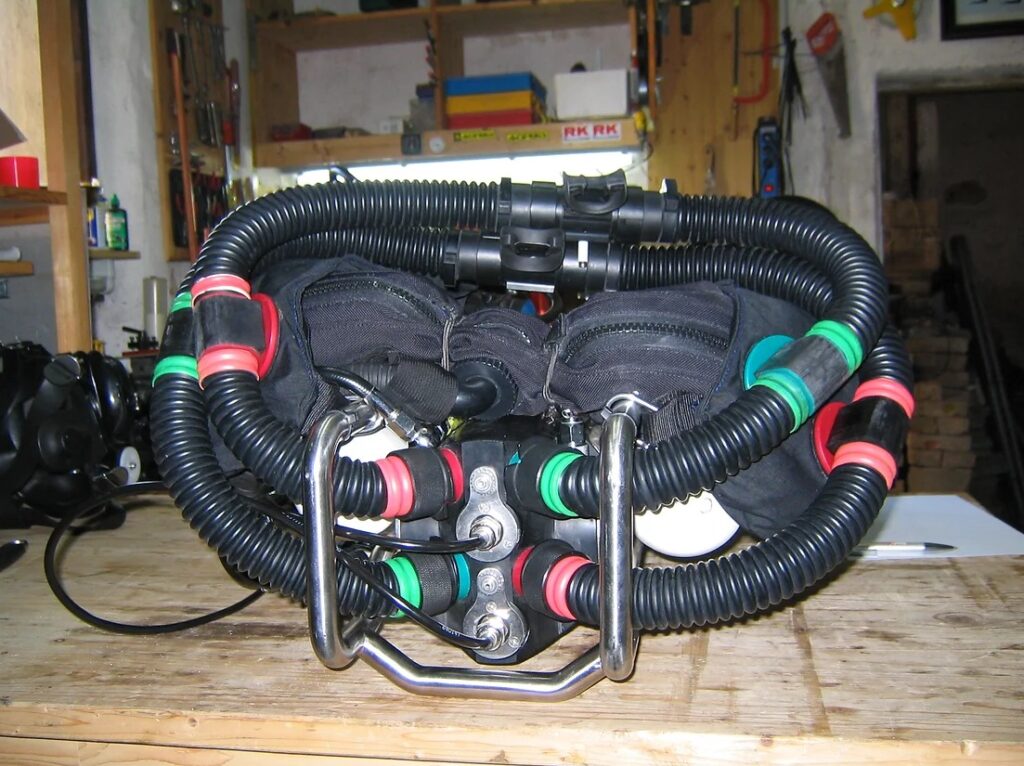
Configuration of the breathing tubes and sensor holders on the distributor head
The manifold head
The manifold head is the second special design feature of the EXIVE. Thanks to its ingenious channel design, it guides the correct inhalation and exhalation side of the lime container to the breathing hoses, contains one ADV per circuit and provides a shaft for the sensor carriers with the oxygen sensors of the monitoring unit. The distributor head also carries the lime tank and is directly connected to it. When dismantling and cleaning the rebreather, the distributor head can be pulled out of the hull tube together with the lime tank like a cartridge.
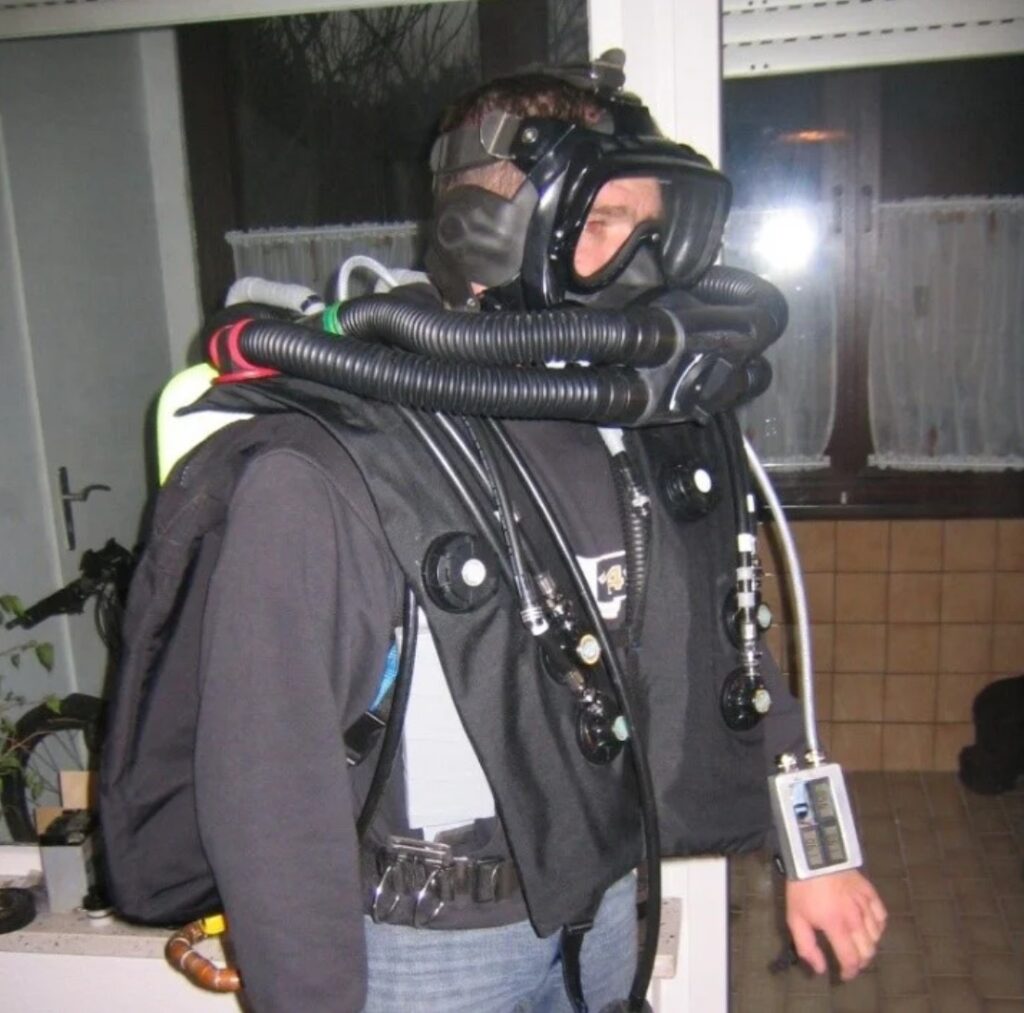
Arrangement of the counterlungs and their connections. The double rebreather has a total of four lungs. Two lungs, each with a different function, are installed together in one cover.
Die Gegenlungen
The counter lungs are the third important piece of expertise in the EXIVE.
They have been positioned in the front-mount arrangement to optimize breathing resistance. This arrangement is partly due to better and clearer hose routing of the dual system. The problem was that the device with two circuits has four lungs. The second lung could not be dispensed with due to the advantage of the flow through the lime tank. The solution was to install two lungs with different functions together in one shell. Only one inhalation and one exhalation lung are required during the dive. As only one circuit is in operation at any one time, only one lung is in operation per envelope. The lungs of the other circuit do not interfere with venting in the envelope. It was therefore necessary to position the adjustable outlet valves on the counterlungs so that they are also easily accessible to the diver. The outlet valve of the unused circuit must be opened by the diver to ensure that the breathing gas escapes. The unused lungs are emptied by displacement and therefore take up almost no space.

A Kirby Morgan EXO 26 full face mask with a connection block for double loop was used.
Mouthpiece and full face mask
EXIVE can be operated with either two mouthpieces and a half face mask or a full face mask. The full face mask is equipped with a switching cylinder for switching between the primary and secondary circuits. The mouthpiece can be completely shut off when the mask is set down floating on the water surface to prevent the circuits from running full. The Kirby Morgan EXO 26 was chosen as the full face mask. The second stage was removed and replaced by a specially developed connection block with a switching roller. The use of the full face mask has the clear advantage that it is impossible to lose the mouthpiece. However, it also has the disadvantage that with four breathing hoses connected, it is much more difficult to turn your head. However, this disadvantage is bearable, as turning the entire upper body is not difficult due to the rebreather’s good trim.

Redundante Überwachungseinheiten mit Sensorblöcken.
Monitoring system
EXIVE has a simple oxygen partial pressure monitoring system consisting of three sensors per circuit. The associated electronic modules were also developed independently and are housed in a milled aluminium casing including batteries. The integration of a rebreather dive computer would be possible in the planned expansion stages. However, this is not absolutely necessary when diving from aboard a submarine. In contrast to technical dives from the surface and with comparatively short bottom times (known as “bounce dives” in professional diving), the dive calculation for saturation diving is based exclusively on tables. One of the reasons for this is the lack of dive computers approved for professional diving with correspondingly validated calculation models. Much more important, however, is the fact that the exit from the diving chamber is only a short section of the actual dive. While the diving equipment is removed, a conventional dive computer or even a permanently connected rebreather controller does not have all the necessary data,
which are required for correct decompression calculation. During a hose-supplied dive
dive, the composition of the breathing gas in the rebreather and in the diving bell is always known. A possible technical solution to the problem would be the development of a dive computer that allows the rebreather to be “plugged in” to the stationary oxygen measuring system in the diving chamber.
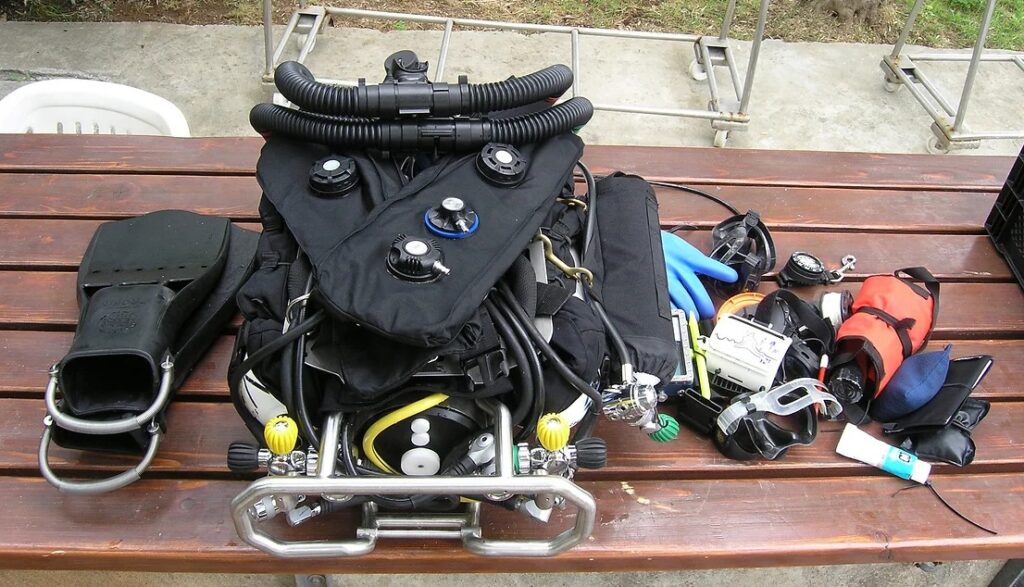
EXIVE ready for transport. In terms of weight and space requirements, the dual-loop rebreather is roughly equivalent to a JJ-CCR in GUE configuration.
Main data
– Weight: Diving clear 48 kg (rebreather with the backplate, harness, filled 7-litre
bottles, filled lime scrubbers, regulators with hoses, counterlungs, breathing loop and monitoring unit);
– Freshwater buoyancy: approx. 5 kg;
– Height: 760 mm (from the base to the top edge of the frame);
– Width: 460 mm (with 7-litre bottles);
– Depth: 250 mm (from the front edge of the backplate);
– Max. Diving depth: The monitor housing is the only pressure-resistant part of the rebreather and has been tested in a component pressure chamber to 180 metres for 24 hours;
– Max. Dive time: up to 6 hours with little physical labour and redundancy.
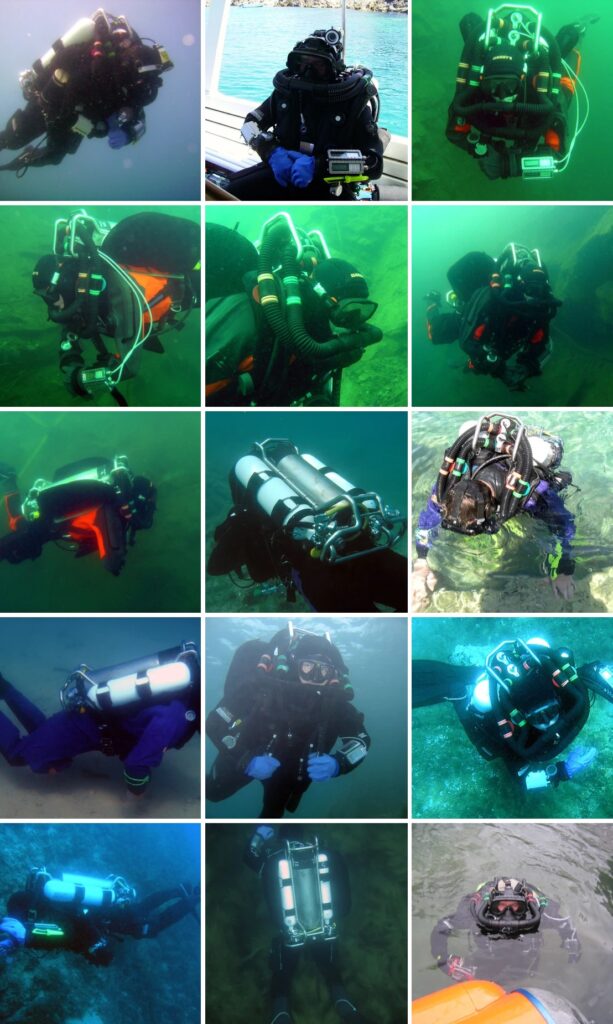
Diving with EXIVE in maximum configuration. A total of 60 diving hours were completed.
Test results
The deepest and most challenging dives with EXIVE took place in Croatia as part of the 1st Tec Diving Week 2008 in Trogir, near Split. The exchange of knowledge with Mark Ellyatt, who also trialled the device, was particularly interesting and instructive. At the time, the Briton held the world record for deep diving, which stood at 313 metres. The following test objectives were pursued during the dives:
– Carrying out initial Trimix dives (e.g. with TX 18/40 or TX 13/45);
– Measurements of breathing resistance at greater depths (62 to 81 metres);
– Testing of rebreather changes at greater depths;
– Checking the set-point adjustability depending on the dive profile;
– Checking the sensor deviation at greater depths;
– General handling of the device in the maximum configuration and at greater depths;
– Long-term testing of condensate entry, long-term ergonomics, diver fatigue and gas consumption (duration 5 hours).
The functionality and manageability of the overall system were successfully demonstrated. The breathing resistance at a depth of 80 metres was subjectively perceived as quite acceptable. Even deeper breaths, in which relatively large quantities of gas are pumped through the device in view of the depth, posed no problem. Switching from the primary to the secondary circuit and back again
and back again at great depth posed no problem.
Adjusting the set point was also straightforward. The constant oxygen supply of 1.1 litres per minute set for the Exive was only too high during long dives when the diver was floating almost motionless. If the diver moves slowly as normal, this oxygen supply meets the consumption quite well. The set point therefore only had to be corrected very rarely at constant depths. The manual control of a CCR with two circuits is also easy to use for deep diving and certainly does not overtax the diver. As previously stated, buoyancy control in shallow water is quite demanding. Four potential buoyancy bodies (two circuits, dry suit and a wing bladder) need to be mastered with practice and skill.
Conclusion
At the end of a long development process, a unique diving device has been created that which, even with the current state of the art, has its raison d’être in some specialized applications. Commercialization of the project would be conceivable in the next step. EXIVE is designed in such a way that it fulfills or can fulfill the properties, performance and safety requirements set out in DIN EN 14143. Unfortunately, further development of the device was discontinued in 2009 for personal reasons. Since then, no dives have been carried out with it. Only one prototype remained, which cost so much over the years that it could have been used to finance several commercial rebreathers off the shelf. In the meantime, rebreather technology has made great progress and numerous new compact devices have entered the market. From today’s perspective, many of the challenges of diving from a submarine would be manageable with side mount or chest mount bail-out rebreathers. In addition, all diving operations on board “Euronaut” ultimately took place at depths of less than 25 metres and were carried out using conventional OC diving equipment. Nevertheless, the EXIVE project was a technical success and a small piece of diving history.
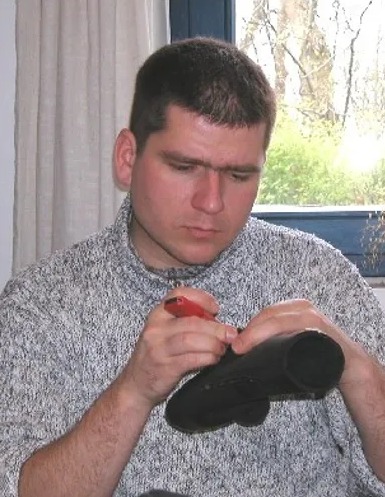
About the developer
Stefan Tietze is a mechanical engineer and was a member of the “Euronaut” project from 2003 to 2009. He learnt scuba diving in the GDR with the GST and trained as a swimmer and ship diver in the German Navy and as a certified professional diver.
This article was first published in “Wetnotes” magazine no. 34
Published with permission by Alexey Konovalov.

Therebreathersite was founded by Jan Willem Bech in 1999. After a diving career of many years, he decided to start technical diving in 1999. He immediately noticed that at that time there was almost no website that contained the history of closed breathing systems. The start for the website led to a huge collection that offered about 1,300 pages of information until 2019. In 2019, a fresh start was made with the website now freely available online for everyone. Therebreathersite is a source of information for divers, researchers, technicians and students. I hope you enjoy browsing the content!
